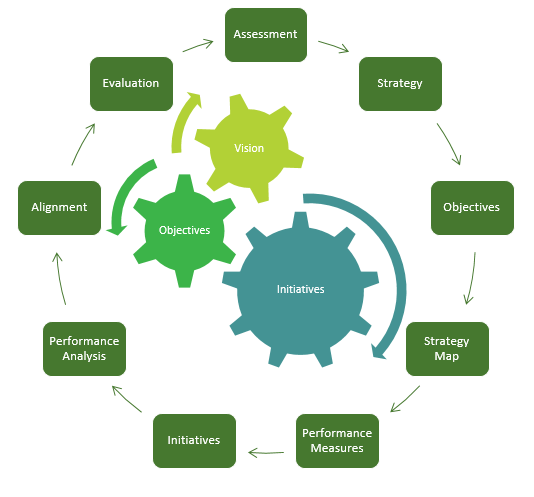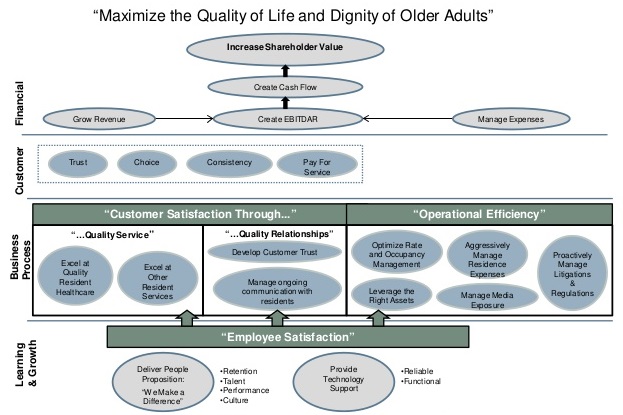
With rapid changes to payment structures, increasing service demands from newer demographics, and fierce competition, aging services and long-term care organizations are turning towards more formal methods to drive strategy forward. Scorecards and performance dashboards offer a visual way to align strategic planning with management operations. This helps an organization organize work according to priorities and achieve strategic goals by creating transparent, measurable connections between programs, processes and people and their relationships with the mission, vision and strategy of the organization.
Commonly, scorecards are developed through a nine step process designed by the Balanced Scorecard Institute.
Step One: Assessment
The scorecard building process starts with a thorough assessment of the organization’s mission and vision, challenges, strengths and opportunities. Preparations also begin for the communication and implementation of the scorecard throughout the organization. Key questions to ask include, “Who are we serving and how?”, “What payment models can we expect going forward?”, and “How are we different from our competitors and other levels of care?”
Step Two: Strategy
Next, a strategic plan is developed based on the assessment findings. This three to five year plan lists specific goals to accomplish and high level strategies that will enable achievement.
Step Three: Objectives
The strategic elements developed earlier are broken down into strategic objectives, which are the basic building blocks of strategy and define the organization’s strategic intent. Objectives are first designed and categorized on the strategic theme level (aligned by perspectives), and then later merged together to produce one set of strategic objectives for the entire organization.
Step Four: Strategy Map
Next, the cause and effect linkages between the organization-wide strategic objectives are detailed to create a strategy map that showcases how the organization provides value to its constituents. The strategy map should answer two fundamental questions: ‘where is the organization?,’ and ‘why are we headed there?’
Example:
Step Five: Performance Measures
In Step Five, performance measures are developed for each strategic objectives. Leading and lagging measures are identified, expected targets and thresholds are established, and baseline and benchmarking data is developed.
Step Six: Initiatives
After developing measures, strategic initiatives are developed to achieve the strategic objectives. To build accountability throughout the organization, ownership of performance measures and strategic initiatives is assigned and documented.
Step Seven: Performance Analysis
In Step Seven, the implementation process begins by developing systems to get the right performance information to the right people at the right time. Automation, where possible, adds structure and discipline to implementing a scorecard, helps transform mountains of organization data into information and knowledge, and helps communicate performance information. In short, automation helps people make better decisions because it offers quick access to actual performance data.
Step Eight: Alignment
Now, the organization-level scorecard is cascaded down into business unit and department scorecards. Cascading translates high-level strategy into lower-level objectives, measures, and operational details. Cascading is the key to organization alignment around strategy. Team and individual scorecards link day-to-day work with department goals and the organization vision. Performance measures are developed for all objectives at all organization levels. As the scorecard management system is cascaded down through the organization, objectives become more operational and tactical, as do the performance measures. Accountability follows the objectives and measures, as ownership is defined at each level. The alignment process should be bi-directional, so that challenges and opportunities known at the ground level make their way up into higher level strategies.
Step Nine: Evaluation
Finally, an evaluation of the completed scorecard is done. During this evaluation, the organization tries to answer questions such as, ‘Are our strategies working?’, ‘Are we measuring the right things?’, and ‘Is this still the right track?’ The constantly changing nature of healthcare means organizations must continually re-evaluate strategy and execution to ensure success.
For a related overview on performance measures and balanced scorecards, see our earlier article: Balanced Scorecards and Key Performance Indicators in Long term and Post-acute Care


